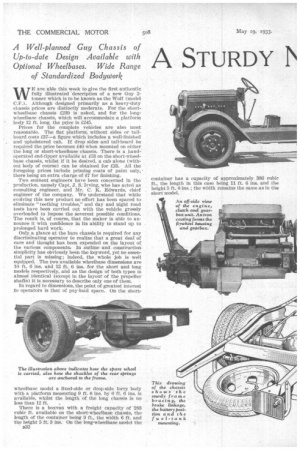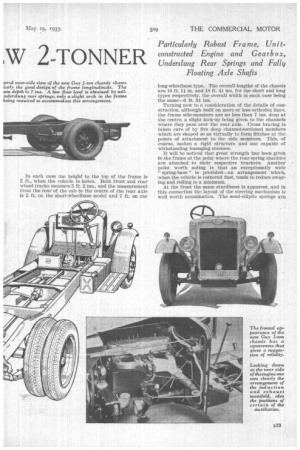A STURDY 1\ 2-TONNER
Page 46

Page 47

Page 48

If you've noticed an error in this article please click here to report it so we can fix it.
WE are able this week to give the first authentic fully illustrated description of a new Guy 2tomer which is to be known as the Wolf (model C.F.). Although designed primarily as a heavy-duty chassis prices are distinctly moderate. For the shortwheelbase chassis 1239 is asked, and for the longwheelbase chassis, which will accommodate a platform body 12 ft. long, the price is £245.
Prices for the complete vehicles are also most reasonable. The flat platform, without sides or tailboard costs £37—a figure which includes a well-finished and upholstered cab. If drop sides and tail-board be required the price becomes £40 when mounted on either the long or short-wheelbase chassis. There is a handoperated end-tipper available at £53 on the short-wheelbase chassis, whilst if it be desired, a cab alone (without body of course) can be obtained for £23. All the foregoing prices include priming coats of paint only, . there being an extra charge of .E7 for finishing.
Two eminent engineers have been concerned in the production, namely Capt. J. S. Irving, who has acted as consulting engineer, and Mr. C. K. Edwards, chief engineer of the company. We understand that while evolving this new product no effort has been spared to eliminate "teething troubles," and day and night road tests have been carried out with the vehicle grossly overloaded to impose the severest possible conditions. The result is, of course, that the maker is able to announce it with confidence in its ability to stand up to prolonged hard work.
Only a glance at the bare chassis is required for any discriminating operator to realize that a great deal of care and thought has. been expended on the layout of the various components. In ,outline and construction simplicity has obviously been the keyword, yet no essential part is missing; indeed, the whole job is well equipped. The two available wheelbase dimensions are 10 ft. 6 ins. and 12 ft. 6 ins, for the short and long models respectively, and as the design of both types is almost identical (except in the layout of the propeller shafts) it is.necessary to describe only one of them.
In regard to dimensions, the point of greatest interest to operators is that of pay-load space. On the short wheelbase model a fixed-side or drop-side lorry body with a platform measuring 9 ft. 6 ins. by 6 ft. 6 ins, is available, whilst the length of the long chassis is no less than 12 ft. _ There is a boxvait with a freight capacity of '283 cubic ft. available on the short-wheelbase chassis, the length of the container being 9 ft., the width 6 ft. and the height 5 ft. 3 ins, On the long-wheelbase model the B32 container has a capacity of approximately 380 cubic ft., the length in this case being 11 ft. 6 ins, and the height 5 ft. 6 ins.; the width retrains the same as in the short model. In each case the height to the top of the frame is 2 ft., when the vehicle is laden. Both front and rear wheel tracks measure 5 ft. 2 ins., and the measurement from the rear of the rah to the centre of the rear axle 5 ft. on the short-wheelbase model and 7 ft. on the
long-wheelbase type. The overall lengths of the chassis are 16 ft. 1i in. and 18 ft. 4lins, for the short and longtypes respectively, the overall width in each case being
the same 6 ft. 3i ins.
Turning now to a consideration of the details of construction, although built on more or less orthodox lines, the frame side-members are no less than 7 ins, deep at the centre, a slight kick-up being given to the channels where they pass over the rear axle. Cross bracing is taken care of by five deep channel-sectioned members which are shaped so as virtually to form flitches at the points of attachment to the side members. This, of course, makes a rigid structure and one capable of withstanding lozenging stresses.
It will be noticed that great strength has been given. to the frame at the point where the rear-spring shackles are attached to their respective brackets: Another point worth noting is that an exceptionally wide "
spring-base" is provided—an arrangement which, when the vehicle is cornered fast, tends to reduce swaying and rolling to a minimum.
• At the front the same sturdiness is apparent, and in this connection the layout of the steering mechanism is well worth examination. The semi-elliptic springs are
shackled at their forward ends, thus the axle moves in an arc almost exactly coincident with the line followed by the drag link. This, of course, gives steady steering qualities, without interaction due to spring deflections. The wheel action is transmitted to the drag link through a cam-and-roller mechanism and self-adjusting eccentric track-rod joints are used. The king-pins are of hardened steel, with hardened steel bushes.
The engine is a particularly sturdy job, modelled on a type which has long been included in the Guy range. Modifications have, of course, been included at the dictates of experience, the result being that higher maximum power and torque figures are now available. In addition, the general accessibility has been improved enormously.
A stiff mono-casting forms the main body of the engine, the four cylinders being bored to 90 mm., which, in conjunction with a piston stroke of 130 ram., gives a swept volume of 3.308 litres. Whilst developing a maximum power of around 50 b.h.p., care has been taken to ensure a high torque figure at moderate speeds. Actually 133 lb.-ft. is available at 1,100 r.p.m.
Three bearings are provided for the crankshaft, each of which is no less than 21 ins, in diameter, and as the connecting rods and pistotts are relatively light in weight the secondary forces are moderate—a fact A which is no doubt responsible for the smooth manner in which the engine runs throughout the whole range of speed. Overhead valves operated by push rods from a camshaft contained in the crankcase are a modern feature, a point of interest being that the combustion chambers (of compact design) are machined all over, thereby
ensuring equality of compression pressure in all four cylinders.
The auxiliary drives are effected entirely by spiral spur gears. At the rear of the camshaft is a vertical shaft which works the oil pump at its lower extremity and the ignition distributor at the upper end where the contacts, etc., are readily get-at-able. Of the gear type, the oil pump delivers through a passage in the crankcase to a filter alongside the distributor, a pipe feeding the main journals of the crankshaft ; thereafter drilled passages in the crankcase casting convey the oil to the camshaft bearings. Further passages drilled in the crankshaft webs lead the lubricant to the crank pins.
A second lead is taken from the filter to the overhead rocker shaft, the overflow being drained away from the forward end of the cylinder head, whence a pipe conveys the oil to the distribution gear.
Iron Casting for Gearbox Unit.
An iron casting for the flywheel-housing and gearbox makes a stiff assembly into which to mount the various transmission units. A single-plate clutch, utilizing a Don Fleaddisc free-member, ensures that the drive is taken up smoothly, whilst a carbon thrust ring is used which is efficient in action and does not require lubrication. Four speeds are provided, the ratios being 6,33, s34 2.97 and 1.7 to 1 for the indirect forward gears, reverse being 10.55 to 1. It should here be mentioned that the standard rearaxle ratio is 5.7 to.1, but optional ratios will be available. A unit is formed by the engine, clutch and gearbox, the whole being mounted on rubber buffers at three points in the frame, thus vibration is reduced to a minimum and chassis distortion is not passed on to the unit.
A Special Front Universal Joint.
On the. short-wheelbase chassis a single open-type propeller shaft is used, whilst on the long chassis a double shaft with a self-aligning centre bearing is provided. In this layout the* universal joints in the centre bearing and at the rear are of the mechanical type, but at the front a special Laycock metal-rubber joint is Interposed with the object of preventing reverberations between the engine and the transmission line.
Mention should be made of the sturdy construction of the rear axle. It is clearly int&Ided to withstand heavy loads, and the axle shafts, being of the fully floating type, are not called upon to chrry any of the weight of the vehicle. The spiral bevel pinion and crown wheel have roller and ball thrust bearings, an important point being that a spigot roller bearing is installed at the rear of the pinion to form a steady. It is interesting to note that the axle shafts can be withdrawn without disturbing the differential gear. Furthermore, the hubs also are carried on ball and roller bearings of large proportions.
Four-wheel brakes are included in the specification. The shoes are of the self-energizing type and provide an effective area of 246 sq. ins. There is an independent screw adjustment for each wheel, whilst cable connections from the frame to the htbs eliminate any possible variation in adjustment due to the load, The pedal applies shoes in all four drums, whilst the centrally disposed lever applies only the rear-wheel shoes.
A 101-gal1on fuel thnk is fitted behind the off-side running board, fuel being fed to the carburetter by an S.U. electric petrol pump .that is accessibly mounted on the carburetter side of the dashboard. Adequate engine cooling is assured by a four-blade fan driven by an endless rubber belt, this drive being utilized also to operate a centrifugal water pump. A feature of this pump is that the gland packing can be renewed with the pump in position, merely by removing one readily , accessible screw.
Equipment is replete in all respects, the standardized prices including spare wheel and tyre of the same size as those fitted to both front and rear wheels, whilst a 12-volt electric lighting and startiT1g. system also is included, besides the usual switches and instruments. The front wings and running boards, the number plates, etc., form part of the normal equipment.




























































































